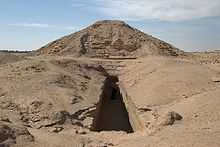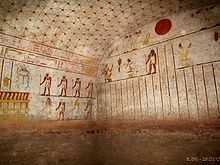El-Kurru

El-Kurru was one of the royal cemeteries used by the Nubian royal family. Reisner excavated the royal pyramids. Most of the pyramids date to the early part of the Kushite period, from Alara of Nubia (795–752 BC) to King Nastasen (335–315 BC).[1]

The area is divided into three parts by two wadis. The central section seems to be the oldest and contains several tumulus type tombs that predate the Kingdom of Napata. Reisner thought that the earliest tomb, Tum.1, dated back to the time of Pharaoh Sheshonq I of Ancient Egypt (ca. 850 BC) and predates the Kingdom of Napata by some 200 years. At the present scholars (Kendall, Hakem, Totok) think the early cemetery stretches back to the Ramesside period and date the earliest burials to the end of the Twentieth Dynasty of Ancient Egypt (ca 1070 BC), although Kendall has reverted his position and now adheres to a dating closer to the one proposed by Reisner.[2]
The highest part of the cemetery contains 4 tumulus tomb (Tum. 1, 2, 4 and 5). To the north, across the northern wadi Tum. 6 is located. To the east of the tumul tombs we find row of at least eight pyramids. One of them partially intrudes on a tumuls tomb (Tum. 19). The southernmost of this row of pyramids belonging to Kashta (presumably to) his wife Pebatjma. Before this row is another row of pyramids which includes those of Piye, Shabaka and Tanutamani.
To the south of the pyramid of Pebatjma one has to cross the southern wadi to reach the southern pyramids. These are the pyramids of the Queens: Naparaye (K. 3), Khensa (K. 4), Qalhata (K.5), and Arty (K.6).[3]
Pyramids and Tombs at El-Kurru
- Tum. 1, the oldest tomb at El-Kurru.
- Tum. 2, the tomb contained a female skull.[3]
- Tum. 4
- Tum. 5
- Tum. 6, tomb located to the north of Tum.1, across the northern wadi.
- Tum. 19, located to the east of the cluster of tumulus tombs. Pyramid K.13 partly obliterated a section of this tomb.
Pyramids dating to the time of the Kingdom of Napata (ca 750 - 650 BC) and later
- K.1 Unknown King. One of the largest pyramids. Located just south and adjacent to the pyramid of Piye (K.17)[3] Dated to ca 362-342 BC (after Harsiotef, before Akhraten).
- K.2
- K.3 – Queen Naparaye, daughter of Piye, Sister-Wife of Taharqa
- K.4 – Queen Khensa, daughter of Kashta, Sister-Wife of Piye
- K.5 – Queen Qalhata, Wife of Shebitku, mother of Tantamani
- K.6 – Queen Arty, daughter of Piye and sister-wife of Shebitku
- K.7 – Possibly Queen Pebatjma, Wife of Kashta. Located next to the pyramid of Kashta (K.8)
- K.8 - King Kashta, father of Piye
- K.9 – Possibly King Alara of Nubia
- K.10
- K.11, the pyramid contained a female skull.[3]
- K.13
- K.14
- K.15 – King Shabaka, son of Kashta, brother of Piye
- K.16 – King Tantamani, son of Shebitku and Queen Qalhata
- K.17 – King Piye, son of Kashta
- K.18 – King Shebitku, son of Piye. Located west of the pyramid of Kashta and south of the tumulus tombs. The pyramid still contained a human skull which may have belonged to Shebitku himself.[3]
- K.21
- K.23, pyramid next to King Kashta (K.8)[3]
- K.52 – Queen Nefrukekashta, Wife of Piye
- K.53 – Queen Tabiry, daughter of Alara of Nubia, wife of Piye
- K.54 – Possibly Peksater, daughter of Kashta, wife of Piye
Horse Burials
Some 120 meters to the north-west of pyramids K.51–K.55 four rows of graves were found which contained horse burials. The rows contained four, eight, eight and four graves respectively. The four graves in the first row likely date to the time of Piye, the tombs in the second row date to the time of Shabaka, the tombs in the third row date to the time of Shebitqo, and the tombs in the fourth and last row date to the time of Tantamani.
The tombs had all been robbed, but enough remained to determined that the horses were all buried in an upright position. The horses were buried with all their trappings.[4]
Royal Cemeteries
For other royal cemeteries see
- Nuri
- Gebel Barkal Royal Cemetery
- Bagrawiyah Royal Cemeteries
- Pyramids of Meroe (Begarawiyah)
References
- ↑ Dows Dunham and M. F. Laming Macadam, Names and Relationships of the Royal Family of Napata, The Journal of Egyptian Archaeology, Vol. 35 (Dec., 1949), pp. 139-149
- ↑ R.G. Morkot, The Black Pharaohs: Egypt's Nubian Rulers, 2000, The Rubicon Press
- ↑ 3.0 3.1 3.2 3.3 3.4 3.5 D. M. Dixon, The Origin of the Kingdom of Kush (Napata-Meroë), The Journal of Egyptian Archaeology, Vol. 50 (Dec., 1964), pp. 121–132
- ↑ George A. Reisner, Note on the Harvard-Boston Excavations at El-Kurruw and Barkal in 1918–1919, The Journal of Egyptian Archaeology, Vol. 6, No. 1 (Jan., 1920), pp. 61–64
Coordinates: 18°24′36″N 31°46′17″E / 18.41000°N 31.77139°E